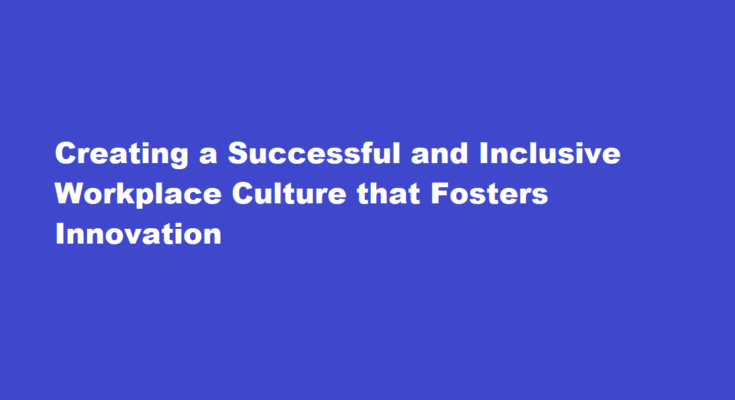Introduction
In today’s dynamic business landscape, innovation has become the lifeblood of successful organisations. To remain competitive and thrive, companies must continuously seek ways to foster a culture of innovation. However, this cannot be achieved without first establishing an inclusive workplace culture that encourages diversity, collaboration, and creativity. In this article, we will explore the key elements of building a successful and inclusive workplace culture that drives innovation.
Embrace Diversity and Inclusion
An inclusive workplace culture starts with recognizing and celebrating the unique perspectives and experiences of each employee. Encourage diversity across all levels of the organisation, including race, gender, age, ethnicity, and background. Studies have shown that diverse teams are more innovative, as they bring a wide range of ideas and problem-solving approaches to the table. Establishing a zero-tolerance policy for discrimination and fostering a sense of belonging for all employees is vital to cultivating an inclusive culture that thrives on innovation.
Promote Psychological Safety
To encourage innovation, employees must feel safe and comfortable sharing their ideas and opinions. Psychological safety is the belief that one can take risks without fear of negative consequences, such as ridicule or punishment. Leaders should actively listen to their team members, provide constructive feedback, and create an environment where mistakes are viewed as learning opportunities. When employees feel psychologically safe, they are more likely to take risks, be creative, and think outside the box.
Support Open Communication
Effective communication is the cornerstone of any successful organisation. Encourage open and transparent communication channels, where employees feel free to express their thoughts, share suggestions, and ask questions without hesitation. Utilize various platforms, such as team meetings, brainstorming sessions, and digital collaboration tools, to foster open dialogue. Additionally, leaders should lead by example and be approachable, promoting a culture where everyone’s voice is heard and valued.
Nurture a Learning Culture
An innovative workplace is one that continuously seeks knowledge and improvement. Encourage a learning culture that promotes ongoing professional development and skill enhancement. Offer training programs, workshops, and opportunities for employees to explore new interests. By investing in their growth, employees will feel more engaged, motivated, and equipped to contribute their best ideas to the organisation.
Set Clear Goals and Autonomy
Employees thrive when they have a sense of purpose and autonomy in their roles. Set clear goals aligned with the organization’s vision, and empower employees to take ownership of their projects. When employees are given the freedom to explore ideas and make decisions, they become more invested in their work and are more likely to innovate and find creative solutions.
Encourage Collaboration
Innovation rarely happens in isolation. Foster a collaborative environment where cross-functional teams can come together to tackle complex challenges. Breaking down silos and encouraging interdepartmental collaboration allows for the exchange of diverse perspectives and knowledge-sharing, leading to innovative breakthroughs.
Recognize and Reward Innovation
Acknowledging and rewarding innovative ideas and efforts is crucial to sustaining a culture of innovation. Implement recognition programs that highlight and celebrate employees who contribute significantly to the organisation’s success through innovative thinking. Publicly recognizing these contributions not only motivates the individual but also inspires others to step forward with their ideas.
FREQUENTLY ASKED QUESTIONS
How a diverse and inclusive workplace promotes innovation in the workplace?
Diverse teams are better at making innovative ideas happen. Diverse teams can bring to bear a broad array of experiences, perspectives, skills, and networks. This expansive resource base allows them to execute on ideas more quickly, efficiently, and cost-effectively.
What are the five principles for creating an inclusive culture?
Through our research, we have identified five inclusive leadership mindsets that shape behaviours: self-awareness, curiosity, courage, vulnerability, and empathy. These mindsets are critical for leaders’ ability to create an environment where all employees feel respected, valued, and able to contribute their best work.
Conclusion
Creating a successful and inclusive workplace culture that fosters innovation requires intentional efforts and a commitment from leadership. By embracing diversity, promoting psychological safety, encouraging open communication, nurturing a learning culture, and providing autonomy, organizations can pave the way for innovation to flourish. Collaboration and recognition further reinforce the innovation mindset, making it a core value that drives the company’s success. As businesses continue to evolve, an inclusive and innovative workplace culture will remain a powerful catalyst for growth and competitiveness.
Read Also : Revolutionising Education Building a Groundbreaking Augmented Reality-based Educational Platform



